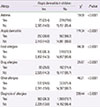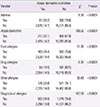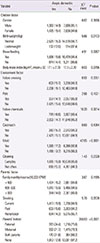Abstract
Purpose
This study aimed to examine the relationship between parent's history of allergic disease and children's atopic dermatitis.
Methods
Data from the 2011 Research on the Current Status of Atopic Disease with Elementary Schools and Kindergartens in Suwon were used for analysis. Among 20,052 persons consenting to the survey, 18,943 who had answered parent's history were included in the study.
Results
The prevalence of father, mother, and parent's allergic disease history were 8.5%, 9.5%, and 2.3%, respective. The children with atopic dermatitis comprised 15.1% of the study population. In multivariate analysis, gender, weight at birth, the practice of breast-feeding, father's educational level, the presence of chemical products in the inside, and the presence of mold were significant risk factors for children's atopic dermatitis. The multivariate-adjusted odds ratio for the occurrence of children's atopic dermatitis was 3.19 (95% confidence interval, 2.57-3.95) when subjects with and without parent's history were compared.
Figures and Tables
Table 2
The difference between paternal history of allergic diseases and atopic dermatitis in school aged children

Table 3
The difference between maternal history of allergic diseases and atopic dermatitis in school aged children

Table 4
Odds ratio of the multiple logistic regression for the atopic dermatitis in school aged children by characteristics

Model I, not adjusted; model II, adjusted by gender, birth weight, breastfeeding, and body mass index in school aged children; model III, additionally adjusted by indoor smoking, pets, indoor chemicals, cockroach, mold, cleaning frequency, and family month income; OR, odds ratio; CI, confidence interval.
*P<0.0001.
References
1. Halbert AR, Weston WL, Morelli JG. Atopic dermatitis: is it an allergic disease? J Am Acad Dermatol. 1995; 33:1008–1018.

3. Kim HY, Jang EY, Sim JH, Kim JH, Chung Y, park SH, et al. Effects of family history on the occurrence of atopic dermatitis in infants. Pediatr Allergy Respir Dis. 2009; 19:106–114.
4. Lee KH. An epidemiologic study on allergies in the community. J Korean Community Nurs. 2000; 11:262–277.
5. Oh JW, Kim KE, Pyun BY, Lee HR, Choung JT, Hong SJ, et al. Nationwide study for epidemiological change of atopic dermatitis in school aged children between 1995 and 2000 and kindergarten aged children in 2003 in Korea. Pediatr Allergy Respir Dis. 2003; 13:227–237.
6. Korea Centers for Disease Control and Prevention. 2012 Atopic dermatitis/asthma preventive management guidelines. Cheongwon: Korea Centers for Disease Control and Prevention;2011.
7. Laughter D, Istvan JA, Tofte SJ, Hanifin JM. The prevalence of atopic dermatitis in Oregon schoolchildren. J Am Acad Dermatol. 2000; 43:649–655.

8. Lehtonen EP, Holmberg-Marttila D, Kaila M. Cumulative prevalence of atopic eczema and related skin symptoms in a well-baby clinic: a retrospective cohort study. Pediatr Allergy Immunol. 2003; 14:405–408.

9. Bjorksten B, Clayton T, Ellwood P, Stewart A, Strachan D. ISAAC Phase III Study Group. Worldwide time trends for symptoms of rhinitis and conjunctivitis: Phase III of the International Study of Asthma and Allergies in Childhood. Pediatr Allergy Immunol. 2008; 19:110–124.

10. Devereux G, Seaton A. Diet as a risk factor for atopy and asthma. J Allergy Clin Immunol. 2005; 115:1109–1117.

11. Eichenfield LF, Hanifin JM, Luger TA, Stevens SR, Pride HB. Consensus conference on pediatric atopic dermatitis. J Am Acad Dermatol. 2003; 49:1088–1095.

12. Pyun BY. Risk factors of atopic dermatitis in young children. Pediatr Allergy Respir Dis. 2005; 15:235–237.
13. Asher MI, Keil U, Anderson HR, Beasley R, Crane J, Martinez F, et al. International Study of Asthma and Allergies in Childhood (ISAAC): rationale and methods. Eur Respir J. 1995; 8:483–491.

14. Kerkhof M, Koopman LP, van Strien RT, Wijga A, Smit HA, Aalberse RC, et al. Risk factors for atopic dermatitis in infants at high risk of allergy: the PIAMA study. Clin Exp Allergy. 2003; 33:1336–1341.

15. Dei-Cas I, Dei-Cas P, Acuna K. Atopic dermatitis and risk factors in poor children from Great Buenos Aires, Argentina. Clin Exp Dermatol. 2009; 34:299–303.

16. Hatakka K, Piirainen L, Pohjavuori S, Poussa T, Savilahti E, Korpela R. Allergy in day care children: prevalence and environmental risk factors. Acta Paediatr. 2009; 98:817–822.

17. Lee JK, Lee HS, Ha JS, Park DJ, Paik DH, Ha KC. Prevalence rate and etiologic risk factors of atopic dermatitis in the preschool children in Changwon. J Environ Health Sci. 2009; 35:169–177.

18. Lee DJ, Kim EH, Jang YH, Lee ES. Epidemiological features of childhood atopic dermatitis in Suwon. Korean J Dermatol. 2010; 48:482–493.
19. Lee JH, Kim EH, Cho J, Kim HY, Suh J, Ahn K, et al. Comparison of prevalence and risk factors of atopic dermatitis by physical examination and questionnaire survey in elementary school children. Pediatr Allergy Respir Dis. 2011; 21:186–196.

20. Ha JS, Jung HJ, Byun HJ, Yoon CS, Kim YH, Oh IB, et al. Evaluation of atopy and its possible association with indoor bioaerosol concentrations and other factors at the residence of children. J Environ Health Sci. 2011; 37:406–417.

21. Sampson HA. Adverse reactions to foods. In : Adkinson NF, Middleton Jr, editors. Middleton's allergy: principle and practice. 6th ed. St. Louise Mosby;2003. p. 305–332.
24. Korea Centers for Disease Control and Prevention. Korea Health Statistics 2012: Korea National Health and Nutrition Examination Survey (KNHANES V). Cheongwon: Korea Centers for Disease Control and Prevention;2013.
25. Spergel JM. Epidemiology of atopic dermatitis and atopic march in children. Immunol Allergy Clin North Am. 2010; 30:269–280.

26. Lee SI, Kim J, Han Y, Ahn K. A proposal: atopic dermatitis organizer (ADO) guideline for children. Asia Pac Allergy. 2011; 1:53–63.

27. Kim HB, Cho YJ, Yoo KH, Kim DY, Kim J, Kim H, et al. Survey on the management of atopic dermatitis. Korean J Asthma Allergy Clin Immunol. 2012; 32:16–20.
29. Kim EJ, Kim HO, Park YM. A study on quality of life and economic burden in Korean patients with atopic dermatitis and their parents. Korean J Dermatol. 2008; 46:160–170.
30. van Beijsterveldt CE, Boomsma DI. Genetics of parentally reported asthma, eczema and rhinitis in 5-yr-old twins. Eur Respir J. 2007; 29:516–521.

31. Moore MM, Rifas-Shiman SL, Rich-Edwards JW, Kleinman KP, Camargo CA Jr, Gold DR, et al. Perinatal predictors of atopic dermatitis occurring in the first six months of life. Pediatrics. 2004; 113(3 Pt 1):468–474.

32. Novak N, Bieber T, Leung DY. Immune mechanisms leading to atopic dermatitis. J Allergy Clin Immunol. 2003; 112:6 Suppl. S128–S139.

33. Schultz-Larsen F. Genetic aspects of atopic eczema. In : Ruzicka T, Ring J, Przybilla B, editors. Handbook of atopic eczema. Berlin/Heidelberg: Springer-Verlag;1991. p. 15–26.
34. Olesen AB, Ellingsen AR, Olesen H, Juul S, Thestrup-Pedersen K. Atopic dermatitis and birth factors: historical follow up by record linkage. BMJ. 1997; 314:1003–1008.

35. Purvis DJ, Thompson JM, Clark PM, Robinson E, Black PN, Wild CJ, et al. Risk factors for atopic dermatitis in New Zealand children at 3.5 years of age. Br J Dermatol. 2005; 152:742–749.

36. Bohme M, Wickman M, Lennart Nordvall S, Svartengren M, Wahlgren CF. Family history and risk of atopic dermatitis in children up to 4 years. Clin Exp Allergy. 2003; 33:1226–1231.

37. Bradley M, Kockum I, Soderhall C, Van Hage-Hamsten M, Luthman H, Nordenskjold M, et al. Characterization by phenotype of families with atopic dermatitis. Acta Derm Venereol. 2000; 80:106–110.
38. Lee YM, Hwang SW. Prevalence and risk factors for atopic dermatitis in pre-school and school aged children. J Korean Acad Child Health Nurs. 2008; 14:285–294.
39. Kramer MS, Guo T, Platt RW, Sevkovskaya Z, Dzikovich I, Collet JP, et al. Does previous infection protect against atopic eczema and recurrent wheeze in infancy? Clin Exp Allergy. 2004; 34:753–756.

40. Williams HC. Atopic dermatitis: new information from epidemiological studies. Br J Hosp Med. 1994; 52:409–412.




 PDF
PDF ePub
ePub Citation
Citation Print
Print



 XML Download
XML Download